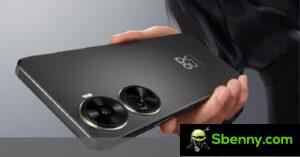Mini phones are on our minds again: when are they not? – but the most recent memory to emerge is just another confirmation that the market doesn’t actually want such devices.
Specifically, we want to talk about the Samsung Galaxy S III mini and its peers. The first one came out in October 2012, about six months after the big S III. We find it a little strange that this “mini” phone has the same display as the original Galaxy S, which was just over two years old at the time. Both had a 4.0-inch Super AMOLED panel with 480 x 800 px (15:9) resolution. This was 30% smaller (in terms of surface area) than the 4.8-inch 16:9 panel of the big S III, so it was truly a “mini”.


Samsung I8190 Galaxy S III mini • Samsung I9300 Galaxy S III
The meaning of “mini” will continue to change, and quite rapidly. And it was also deceptive. Yes, the minis were smaller, but a more noticeable difference between them and the flagships they were named after was the hardware specs. It would have been more accurate to call this phone the “mid-range Galaxy S III”.
The Galaxy S III mini bore the name of a flagship, but was itself far from a flagship: it had a dual-core Cortex-A9 CPU (1.0GHz) and a Mali-400 GPU, this NovaThor chipset U8420 was weaker than the Exynos 4210 Double in the Galaxy S II from the year before. There was no comparison with the full-on flagship’s quad-core CPU. The NovaThor was paired with 1GB of RAM (like the big S III, surprisingly) and 8GB of storage, plus a microSD slot.
Furthermore, the WVGA display had a low pixel density, the main camera was an unremarkable 5 MP camera with 720p video capture (compared to the S III’s 8 MP 1080p), the 0.3 MP selfie camera was even more basic ( compared to the 1.9 MP module for the S III).

This wasn’t a stripped down Galaxy S III, it was a mid-range style to look like the more expensive phone. The Galaxy S Advance was essentially the same phone, except significantly cheaper. If you could get over its outdated appearance (based on the S II), you could save a lot of money. The Galaxy S III mini was expensive for what it was, so it couldn’t keep up with the sales of the real Galaxy S III.
This didn’t discourage Samsung, which tried again the following year with the Galaxy S4 mini. This had a 4.3” 16:9 display (540 x 960px), comparable to the Galaxy S II’s 4.3” 15:9 display (480 x 800px). Crucially, it was 26% smaller than the current Galaxy S4. However, the pixel density was nowhere near the S4’s 1080p display (256ppi versus 441ppi).


Samsung I9190Galaxy S4mini • Samsung I9500Galaxy S4
The S4 mini was relatively powerful: the Snapdragon 400 with its dual-core CPU Krait 300 and Adreno 305 could not compete with the Exynos 4310 (octa-core CPU with A15+A7 cores and PowerVR SGX544MP3), but it was still a snappy chipset. It comes with 1.5GB of RAM (half a gig less than the S4) and 8GB of storage, again with a microSD expansion (those were the days).

The camera also saw a significant upgrade with an 8MP sensor – not quite up to the S4’s 13MP standard, but at least it matched it with 1080p video recording at 30fps. And the 1.9MP selfie camera was comparable too.
Overall, the Samsung Galaxy S4 mini was a much better phone than the S III mini. Still far from a true flagship, but something you wouldn’t mind buying. However, it was still quite expensive at €380 (a real S4 could be found for around €100 more with a little effort).

Another year, another mini: the Samsung Galaxy S5 mini, to be precise. This was even larger with a 4.5″ display, this time a 720p panel which finally put it into Retina display territory. The real Galaxy S5 only grew slightly larger than the S4 and had a 5.5″ 1080p display. 1 inch, so the S5’s mini display was only 22% smaller.


Samsung Galaxy S5 mini • Samsung Galaxy S5
The S5’s defining feature was the IP67 rating for dust and water resistance, a first for the flagship line (not counting the Galaxy S4 Active, which is another story) and something that would become the norm in the future. To the S5 mini’s credit, it too had an IP67 rating.
That said, Samsung really let the performance slide: The Snapdragon 400 wasn’t great, but at least the Krait cores offered solid single-core performance. The Galaxy S5 mini had a quad Cortex-A7 CPU and a Mali-400MP4 GPU, which was not competitive. Additionally, the camera has received virtually no upgrades compared to the S4 mini, while the Galaxy S5 has moved up to 4K video.

Samsung Galaxy S5 mini
The Galaxy S4 mini showed promise, but the S5 mini was very similar to the S III mini: A+ in looks, C- in features. And the price was even higher than it should have been.
Unfortunately, this is where the story ends. There were some rumors about a Galaxy S6 mini with a 4.6″/4.7″ display and a Snapdragon 808 chipset, but no such phone was ever released (in fact, Samsung dodged the Snapdragon 808 and 810 altogether, but this is another story too).
We don’t have specific numbers on how many Galaxy S minis Samsung managed to sell. A 2013 report described sales of the S4 mini as “lackluster” without going into further detail. After all, if the mini experiment had been successful, Samsung would have produced more of them – and still makes them mini today.
But the Galaxy S23 is as small as Samsung is willing to make it. In fact, the S23 is Samsung’s smallest smartphone, period – even the entry level A0 and M0 devices are larger. To be honest, few modern smartphones are as small as the S23. Not that we would call it “mini”.







Start a new Thread